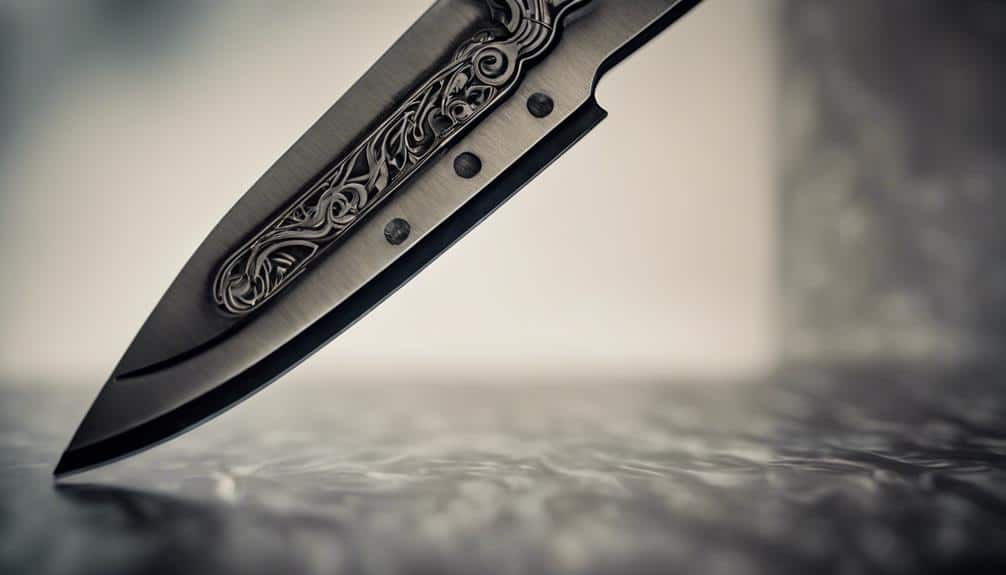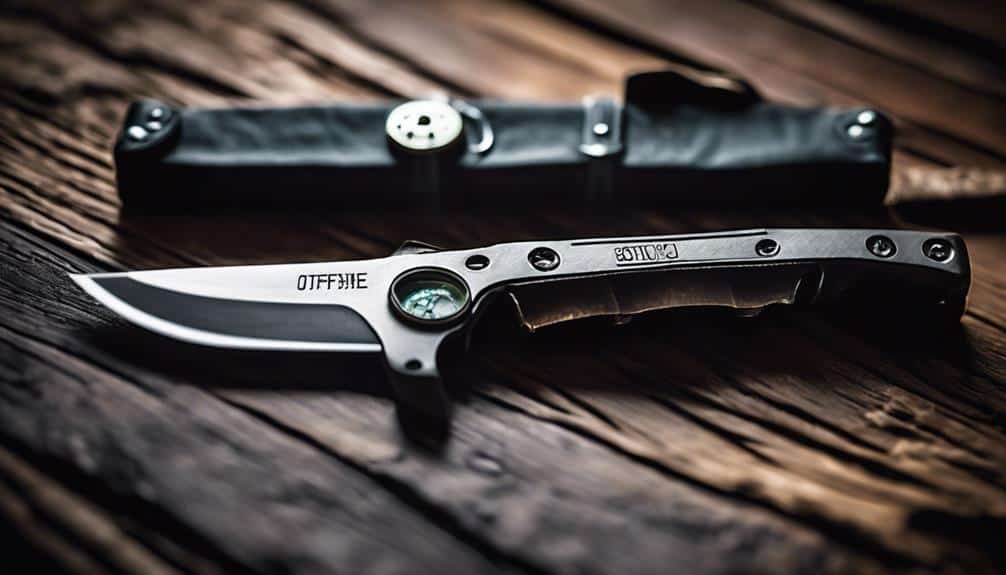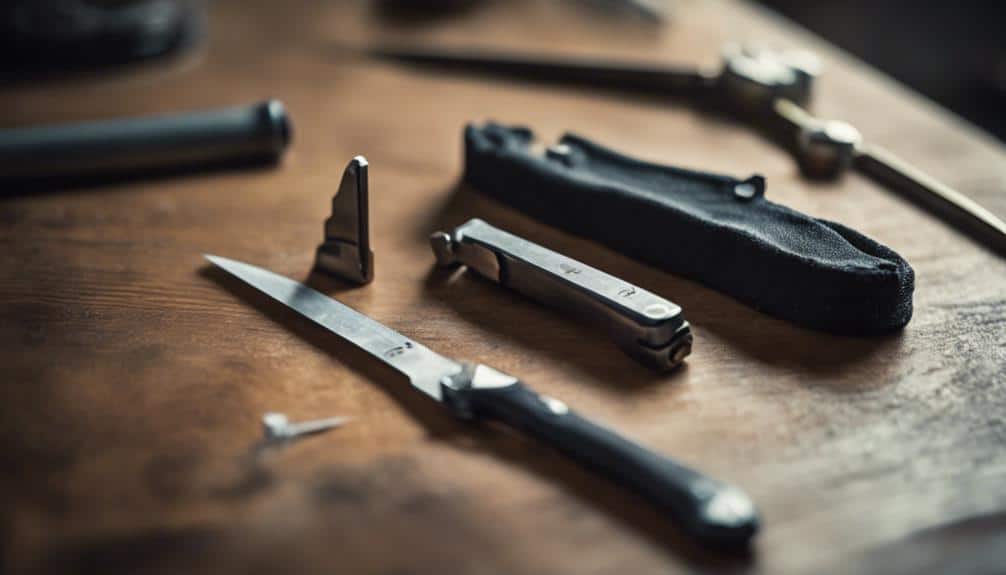An
OTF (Out-The-Front) knife is a versatile tool where the blade shoots out from the front of the handle with the push of a button or lever, offering slick one-handed operation. They come in
double-action models, which deploy and retract the blade automatically, and single-action ones, requiring manual retraction. Perfect for
everyday use, these
knives pack a punch in convenience and precision, suited for everything from opening packages to self-defense. But wait, there’s more! By exploring further, you’ll uncover
essential maintenance tips, legal nuances, and must-know brands that could make you a connoisseur of this unique tool.
Definition and Mechanism
An
OTF blade, abbreviated for
Out The Front blade, operates with a unique mechanism where the blade deploys and retracts through a
switch on the handle. This type of automatic blade stands out by offering both
speed and convenience.
Imagine yourself in a situation where you need to cut something quickly — with an OTF blade, you simply slide the switch, and voilà, the blade is ready for action.
One of the most captivating aspects of an
OTF blade is its
double-action feature. This means you can deploy and retract the blade using the same switch, all with one hand. It’s like having a
mini lightsaber in your pocket, ready to handle any cutting task that comes your way.
Whether you’re opening packages, cutting rope, or even preparing a campsite, the OTF blade’s mechanism guarantees you’re not fumbling around with both hands.
The switch-slide mechanism isn’t just
practical; it’s also incredibly engaging. There’s something almost mesmerizing about watching the blade shoot out and retract with a dramatic snap. Plus, it adds a touch of style to mundane tasks, making you feel a bit like an
action hero in your daily life.
Types of OTF Knives
As you explore the world of OTF knives further, you’ll discover a variety of types, each with its own unique features and benefits. Unlike fixed blades, OTF knives offer the excitement of dramatic blade deployment with just one hand, making them a favorite among enthusiasts and in high-profile films. Here’s a closer look at the main types you’ll encounter:
- Double-Action OTF Knives: These are the most common and user-friendly. A single switch allows you to deploy and retract the blade, making them perfect for quick, one-handed operation. Think of them as the Swiss Army knife of the OTF world—versatile and efficient.
- Single-Action OTF Knives: These require a bit more effort, as you’ll need to manually retract the blade after deployment. They mightn’t be as convenient as double-action types, but they often have stronger springs, making the blade deployment super satisfying.
- Manual OTF Knives: Knives like the Reate Exo gravity knife fall into this category. They offer a unique mechanism where gravity assists in the blade deployment, adding a bit of flair and skill to your knife-wielding experience.
- Compact Double-Edged OTF Knives: These knives offer a compact carry option with double-edged blades, making them handy for various cutting tasks while keeping a low profile in your pocket.
Benefits of OTF Knives
When you choose an
OTF knife, you get the ease of
one-handed operation for a variety of cutting tasks. Imagine you’re out camping, and you need to quickly cut some rope—just a flick of your thumb, and your OTF knife is ready for action. The
automatic deployment mechanism isn’t just satisfying; it’s a game-changer for quick blade access.
Double-action OTF knives, which allow you to both deploy and retract the blade with the same switch, make your life even easier. You won’t have to fumble around trying to close it; just flip the switch back, and you’re done.
Practicality and
compact design make OTF knives popular for both
tactical use and everyday carry. Whether you’re a first responder needing to act swiftly or just someone who likes having a reliable tool at hand, an OTF knife is invaluable.
Make sure to appreciate the
safety features as well. These knives reduce the risk of accidentally closing the blade on your hand, making them safer compared to
traditional folding knives.
Buying Guide
Before you buy an OTF knife, consider factors like blade play, sound, reliability, ergonomics, pocket clip, switch comfort, and blade shape. These elements will greatly affect your overall user experience and satisfaction with the knife.
When diving into the world of OTF knives, keep the following in mind:
- Budget considerations: Higher-end models often have less blade play and smoother action. Decide how much you’re willing to spend to balance quality and affordability.
- Blade customization: Many OTF knives offer options for different blade shapes and finishes. Think about what fits your needs and style best, whether it’s a sleek tanto or a classic drop point.
- User experience: Consider how the knife feels in your hand. Is the switch easy to use? Does the pocket clip offer secure carrying? Your comfort and ease of use are essential.
- Reliability: Opt for brands with a reputation for reliability. Higher-quality OTF knives are less likely to misfire or have issues with the blade track.
Maintenance Tips
To keep your OTF knife performing flawlessly,
regular cleaning and
proper lubrication are important, just like a car needs an oil change.
You’ll also want to familiarize yourself with the manufacturer’s warranty and available maintenance services to guarantee your knife stays in excellent condition.
Regular Cleaning Routine
Maintaining your OTF knife’s performance starts with regular cleaning and proper care. You should establish a cleaning frequency based on how often you use the knife. A good rule of thumb is to clean it every few weeks if you use it frequently, or after each use if it contacts dirt or moisture.
When cleaning, you’ll need some necessary tools: a clean cloth, compressed air, and a simple screwdriver. Here are some steps to guide you:
- Disassemble the Knife: Carefully take apart the knife to access all components. This prevents grime buildup in hard-to-reach areas.
- Wipe Down Components: Use a clean cloth to wipe each part. Be gentle to avoid scratches.
- Remove Debris with Compressed Air: Blast compressed air into the nooks and crannies to get rid of hidden dust and debris.
- Inspect for Damage: While you’re at it, check for wear and tear, cracks, or rust spots.
Avoid common mistakes like using harsh chemicals, which can damage the blade, or applying excessive force, which could harm the delicate mechanisms.
Proper Lubrication Practices
Once your OTF knife is clean, applying
proper lubrication keeps its mechanisms running smoothly. Start by choosing a
high-quality lubricant specifically designed for knives. Not all lubricants are equal; some can damage the materials of your OTF knife, so select one that’s compatible with your knife’s specs.
For effective lubricant application, focus on the
blade pivot area and the
switch mechanism. Just a few drops will do the trick—
over-lubrication can attract dirt and gunk, which might turn your sleek tool into a gritty nightmare. After applying, work the blade a few times to distribute the lubricant evenly.
Next, let’s talk about
lubricant removal techniques. If you overdo it or notice buildup, use a
cotton swab or soft cloth to wipe away the excess. This keeps your knife clean and functioning at its best.
When it comes to lubricant storage,
best practices suggest keeping it in a cool, dry place. This prevents the lubricant from degrading or evaporating, ensuring it’s always ready when you need it. Proper lubrication practices are key to maintaining your OTF knife’s reliability and longevity, so don’t skimp on this essential step.
Warranty and Services
Understanding your OTF knife’s warranty and available maintenance services can save you time and money in the long run. Knowing what’s covered under your warranty can help you avoid unnecessary expenses, while taking advantage of service options can keep your knife in peak condition.
Regular maintenance, like cleaning and lubrication, is essential, but sometimes you might need a bit more help.
Here are four tips to make the most of your warranty and services:
- Know Your Warranty Coverage: Familiarize yourself with what the manufacturer covers. This can include defects in materials or workmanship but may not cover misuse or unauthorized repairs.
- Utilize Service Options: Many manufacturers offer professional maintenance services. Don’t hesitate to send your knife in for a tune-up; it’s like a spa day for your blade.
- Follow Troubleshooting Tips: Sometimes, simple issues like a sticky blade can be resolved with basic troubleshooting tips provided by the manufacturer. Check the manual or website for guidance.
- Stick to the Maintenance Schedule: Adhering to the recommended maintenance schedule helps prevent premature wear and tear, keeping your knife reliable and your warranty intact.
Keeping these tips in mind ensures your OTF knife remains a dependable companion for years to come!
Legal and Safety Aspects
When owning an
OTF knife, you’ve got to be aware of the
local laws, which can be as varied as the toppings on a pizza, so always check your state or country regulations before carrying one.
Proper handling is essential, as these knives can deploy faster than you can say ‘ouch,’ making
safety precautions non-negotiable.
Ignoring these aspects can land you in hot water, with legal consequences ranging from hefty fines to more severe penalties, so it’s wise to always stay informed and cautious.
Local Law Compliance
Before you purchase or carry an OTF knife, it’s crucial to examine your local laws to evade any legal trouble. Different jurisdictions have diverse regulations, and understanding these can prevent you from unforeseen legal headaches. Law enforcement officers are vigilant about enforcing these laws, and being caught off guard can result in severe consequences.
Here are a few key points to keep in mind:
- Research Local Legislation: Various areas have different rules about OTF knives. What’s permissible in one state might be prohibited in another.
- Penalties and Fines: Carrying an OTF knife where it’s forbidden can lead to substantial fines, confiscation of the knife, or even criminal charges. Ignorance is no excuse!
- Compliance Measures: To make sure you’re following the rules, always check local government websites or seek advice from a legal expert. It’s wiser to be cautious than regretful.
- Law Enforcement: Officers are trained to identify illegal weapons. If you’re discovered with an OTF knife in a restricted area, it can result in immediate legal action.
Proper Handling Techniques
After confirming your compliance with local laws, it’s important to focus on the
proper handling techniques to safely use an OTF knife. Knowing how to handle an OTF knife correctly can mean the difference between a useful tool and a dangerous weapon. Start with proper storage: always keep your knife in a secure, dry place, ideally in a sheath or dedicated case to prevent accidental deployment.
When it comes to
safe handling, never point the blade towards yourself or others, and always keep your fingers away from the path of the blade.
Engage the safety lock if your knife has one. Practice deploying and retracting the blade in a
controlled environment to get comfortable with the mechanism.
Mastering usage techniques is key. Use your OTF knife for its
intended purposes—cutting, slicing, or piercing—rather than as a pry bar or screwdriver. Misuse can damage the knife and increase the risk of injury.
Legal Carry Consequences
Carrying an OTF knife without understanding local laws can land you in serious legal trouble. Different jurisdictions have varying regulations, so it’s crucial to do your homework before carrying one. Neglecting to do so could mean facing hefty penalties imposed, including fines, confiscation, or even criminal charges.
Here’s what you need to know to stay on the right side of the law:
- Jurisdiction Differences: Laws differ dramatically between states and countries. What’s legal in one place might be a serious offense in another. Always check local regulations to avoid unexpected enforcement measures.
- Possible Penalties: If caught carrying an OTF knife where it’s prohibited, you could face penalties imposed such as fines or even jail time. Confiscation of your knife is almost a given in these scenarios.
- Safety Concerns: Misuse or improper handling can lead to accidents, making safety precautions essential. You wouldn’t want an everyday tool to turn into a dangerous liability, right?
- Ramifications: Violating knife laws can have long-term consequences faced, including a criminal record. That’s not a souvenir anyone wants from their OTF knife experience.
Advantages and Drawbacks
Often praised for their convenience, OTF knives offer significant advantages like one-handed operation and a safer blade deployment mechanism. These knives are perfect for those moments when you need to quickly access a blade, whether you’re in the middle of a DIY project or simply opening a stubborn package. With their compact design, they fit easily into your pocket, making them versatile for everyday use.
However, as with any tool, there are both pros and cons. Here’s a quick breakdown of what you can expect:
- Safety features and operational efficiency: OTF knives often come with safety mechanisms that prevent accidental deployments, making them ideal for safe, quick access.
- Deployment mechanism and user experience: Double action models allow for smooth, one-handed deployment and retraction, enhancing your user experience.
- Reliability concerns: The complexity of the spring mechanism can sometimes lead to reliability issues, particularly in high-stress situations.
- Maintenance requirements: OTF knives need regular maintenance to make sure the deployment mechanism stays functional, which can be a bit of a hassle.
While they’re incredibly handy, it’s crucial to weigh these factors against your specific needs. If you’re not planning on using it for high-intensity tasks, an OTF knife might just be your new best friend.
Frequently Asked Questions
What Does OTF Mean in a Knife?
OTF stands for Out The Front, describing a knife’s unique deployment via a switch slide. You should understand OTF knife operation, be aware of OTF knife legality in your area, and always practice OTF knife safety.
What Is the Purpose of an OTF Knife?
The purpose of an OTF knife is quick blade deployment for everyday tasks and self defense. You can easily maintain the blade, ensuring it’s always ready for precise cutting tasks with just one hand.
Why Are OTF Knives Illegal?
OTF knives are illegal in some areas because of the risks they pose to public safety. Regulations aim to prevent their misuse in criminal activities. Always check local laws to guarantee you’re not violating any restrictions.
What’s the Difference Between an OTF Knife and a Switchblade?
The difference between an OTF knife and a switchblade lies in their blade deployment. OTF knives extend the blade straight out, while other switchblades open from the side. Legal ramifications often depend on the specific mechanism comparison.








Excellent blog here! Also your site loads up very fast! What web host are you using?
Can I get your affiliate link tto your host? I wish my website lokaded up aas fast as yours
lol https://odessaforum.biz.ua/
Thank you, I am happy you enjoyed the blog. Check back daily as we add new articles daily.
If some one wants expert view concerning blogging after that i recommend him/her to go
to see this blog, Keep up the good job.
Thank you for your kind words
Thanks for another informative website. Where else may just I am getting that type of info
written in such a perfect manner? I’ve a project that I’m simply now
operating on, and I have been on the look out for such information.
Your welcome. Check back often as we add new information daily
Whoa! This blog looks exactly like my old one!
It’s on a totally different subject but it has pretty much the same page layout and design. Great choice of colors!
There is certainly a great deal to know about this subject.
I love all of the points you’ve made.
Thank you for your kind words. Check back daily for new content
Have you ever thought about including a little bit more than just your articles?
I mean, what you say is important and all. But think about if you added some great visuals or video clips to give your posts more, “pop”!
Your content is excellent but with images and video clips, this blog
could undeniably be one of the most beneficial in its field.
Fantastic blog!
Heya i’m for the primary time here. I found this board and
I to find It really useful & it helped me out a lot. I hope to give
one thing again and help others like you aided me.
Thank you for your kind words. Check Back Daily for new Articles
At this time I am going away to do my breakfast, when having my breakfast coming over again to read additional news.
Hello just wanted to give you a brief heads up and let you
know a few of the images aren’t loading correctly.
I’m not sure why but I think its a linking issue.
I’ve tried it in two different internet browsers and both show the
same results.
Review my web site – Remington 5 Gallon Bucket of 22LR Bucket o Bullets .22 LR 36 Grain Rimfire Ammo
I’m not that much of a online reader to be honest but your blogs really nice,
keep it up! I’ll go ahead and bookmark your website to come back
in the future. Many thanks
We are happy you enjoy them. We add new articles daily
Thanks for sharing your thoughts about Big chief
disposable vape. Regards
I’m gone to tell my little brother, that he should also go to see
this blog on regular basis to obtain updated from latest gossip.
Every weekend i used to pay a visit this website, as i wish for enjoyment, as this this website conations really
pleasant funny stuff too.